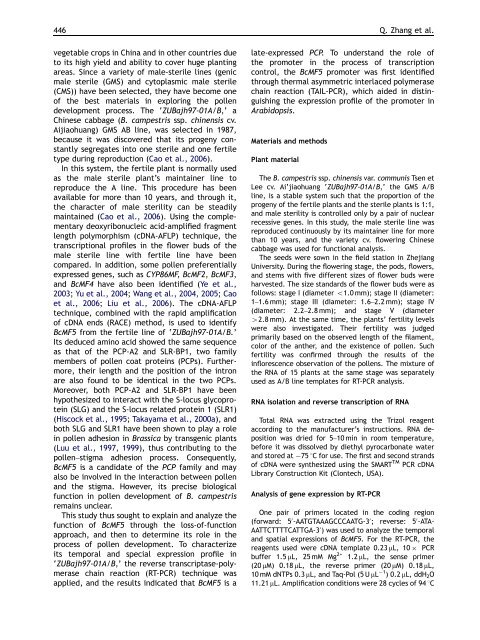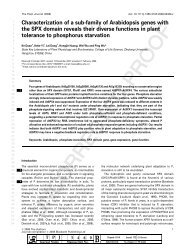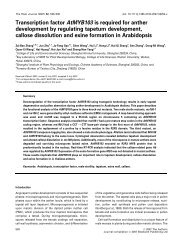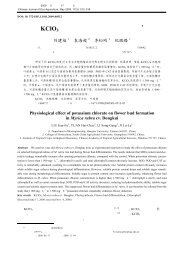Brassica campestris L. ssp. chinensis M
Brassica campestris L. ssp. chinensis M
Brassica campestris L. ssp. chinensis M
Create successful ePaper yourself
Turn your PDF publications into a flip-book with our unique Google optimized e-Paper software.
446<br />
vegetable crops in China and in other countries due<br />
to its high yield and ability to cover huge planting<br />
areas. Since a variety of male-sterile lines (genic<br />
male sterile (GMS) and cytoplasmic male sterile<br />
(CMS)) have been selected, they have become one<br />
of the best materials in exploring the pollen<br />
development process. The ‘ZUBajh97-01A/B,’ a<br />
Chinese cabbage (B. <strong>campestris</strong> <strong>ssp</strong>. <strong>chinensis</strong> cv.<br />
Aijiaohuang) GMS AB line, was selected in 1987,<br />
because it was discovered that its progeny constantly<br />
segregates into one sterile and one fertile<br />
type during reproduction (Cao et al., 2006).<br />
In this system, the fertile plant is normally used<br />
as the male sterile plant’s maintainer line to<br />
reproduce the A line. This procedure has been<br />
available for more than 10 years, and through it,<br />
the character of male sterility can be steadily<br />
maintained (Cao et al., 2006). Using the complementary<br />
deoxyribonucleic acid-amplified fragment<br />
length polymorphism (cDNA-AFLP) technique, the<br />
transcriptional profiles in the flower buds of the<br />
male sterile line with fertile line have been<br />
compared. In addition, some pollen preferentially<br />
expressed genes, such as CYP86MF, BcMF2, BcMF3,<br />
and BcMF4 have also been identified (Ye et al.,<br />
2003; Yu et al., 2004; Wang et al., 2004, 2005; Cao<br />
et al., 2006; Liu et al., 2006). The cDNA-AFLP<br />
technique, combined with the rapid amplification<br />
of cDNA ends (RACE) method, is used to identify<br />
BcMF5 from the fertile line of ‘ZUBajh97-01A/B.’<br />
Its deduced amino acid showed the same sequence<br />
as that of the PCP-A2 and SLR-BP1, two family<br />
members of pollen coat proteins (PCPs). Furthermore,<br />
their length and the position of the intron<br />
are also found to be identical in the two PCPs.<br />
Moreover, both PCP-A2 and SLR-BP1 have been<br />
hypothesized to interact with the S-locus glycoprotein<br />
(SLG) and the S-locus related protein 1 (SLR1)<br />
(Hiscock et al., 1995; Takayama et al., 2000a), and<br />
both SLG and SLR1 have been shown to play a role<br />
in pollen adhesion in <strong>Brassica</strong> by transgenic plants<br />
(Luu et al., 1997, 1999), thus contributing to the<br />
pollen–stigma adhesion process. Consequently,<br />
BcMF5 is a candidate of the PCP family and may<br />
also be involved in the interaction between pollen<br />
and the stigma. However, its precise biological<br />
function in pollen development of B. <strong>campestris</strong><br />
remains unclear.<br />
This study thus sought to explain and analyze the<br />
function of BcMF5 through the loss-of-function<br />
approach, and then to determine its role in the<br />
process of pollen development. To characterize<br />
its temporal and special expression profile in<br />
‘ZUBajh97-01A/B,’ the reverse transcriptase-polymerase<br />
chain reaction (RT-PCR) technique was<br />
applied, and the results indicated that BcMF5 is a<br />
ARTICLE IN PRESS<br />
late-expressed PCP. To understand the role of<br />
the promoter in the process of transcription<br />
control, the BcMF5 promoter was first identified<br />
through thermal asymmetric interlaced polymerase<br />
chain reaction (TAIL-PCR), which aided in distinguishing<br />
the expression profile of the promoter in<br />
Arabidopsis.<br />
Materials and methods<br />
Plant material<br />
The B. <strong>campestris</strong> <strong>ssp</strong>. <strong>chinensis</strong> var. communis Tsen et<br />
Lee cv. Ai’jiaohuang ‘ZUBajh97-01A/B,’ the GMS A/B<br />
line, is a stable system such that the proportion of the<br />
progeny of the fertile plants and the sterile plants is 1:1,<br />
and male sterility is controlled only by a pair of nuclear<br />
recessive genes. In this study, the male sterile line was<br />
reproduced continuously by its maintainer line for more<br />
than 10 years, and the variety cv. flowering Chinese<br />
cabbage was used for functional analysis.<br />
The seeds were sown in the field station in Zhejiang<br />
University. During the flowering stage, the pods, flowers,<br />
and stems with five different sizes of flower buds were<br />
harvested. The size standards of the flower buds were as<br />
follows: stage I (diameter o1.0 mm); stage II (diameter:<br />
1–1.6 mm); stage III (diameter: 1.6–2.2 mm); stage IV<br />
(diameter: 2.2–2.8 mm); and stage V (diameter<br />
42.8 mm). At the same time, the plants’ fertility levels<br />
were also investigated. Their fertility was judged<br />
primarily based on the observed length of the filament,<br />
color of the anther, and the existence of pollen. Such<br />
fertility was confirmed through the results of the<br />
inflorescence observation of the pollens. The mixture of<br />
the RNA of 15 plants at the same stage was separately<br />
used as A/B line templates for RT-PCR analysis.<br />
RNA isolation and reverse transcription of RNA<br />
Total RNA was extracted using the Trizol reagent<br />
according to the manufacturer’s instructions. RNA deposition<br />
was dried for 5–10 min in room temperature,<br />
before it was dissolved by diethyl pyrocarbonate water<br />
and stored at 75 1C for use. The first and second strands<br />
of cDNA were synthesized using the SMART TM PCR cDNA<br />
Library Construction Kit (Clontech, USA).<br />
Analysis of gene expression by RT-PCR<br />
Q. Zhang et al.<br />
One pair of primers located in the coding region<br />
(forward: 5 0 -AATGTAAAGCCCAATG-3 0 ; reverse: 5 0 -ATA-<br />
AATTCTTTTCATTGA-3 0 ) was used to analyze the temporal<br />
and spatial expressions of BcMF5. For the RT-PCR, the<br />
reagents used were cDNA template 0.23 mL, 10 PCR<br />
buffer 1.5 mL, 25 mM Mg 2+ 1.2 mL, the sense primer<br />
(20 mM) 0.18 mL, the reverse primer (20 mM) 0.18 mL,<br />
10 mM dNTPs 0.3 mL, and Taq-Pol (5 U mL 1 ) 0.2 mL, ddH 2O<br />
11.21 mL. Amplification conditions were 28 cycles of 94 1C








